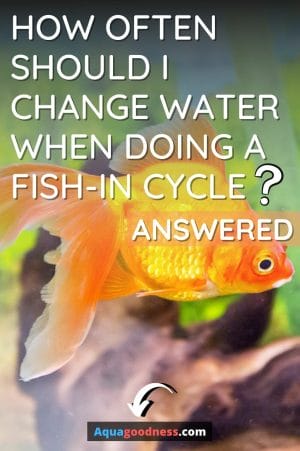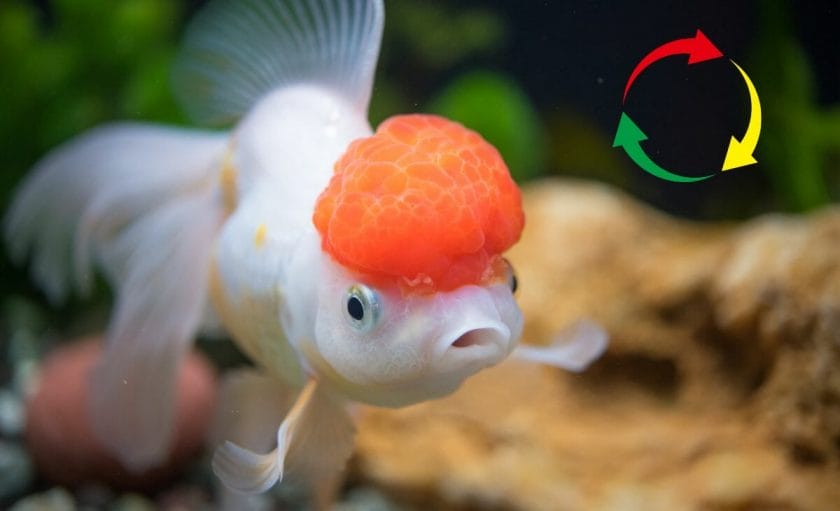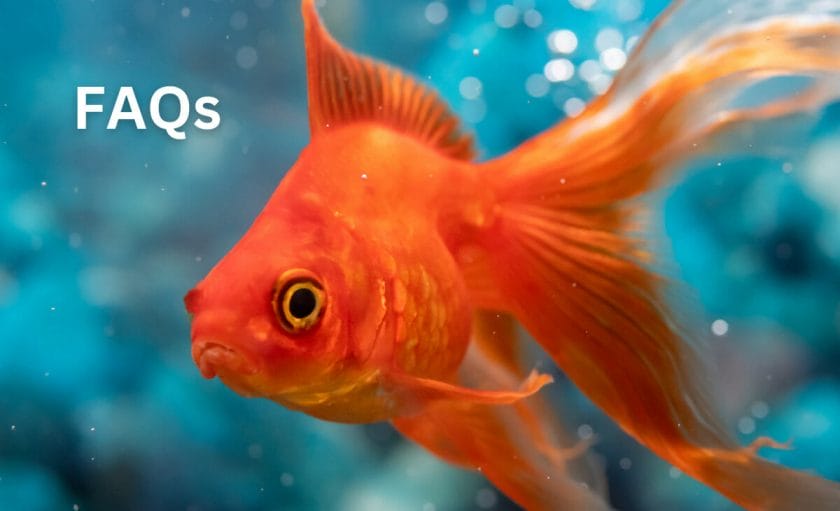Are you wondering how often you need to change water when doing a fish-in cycle?
How often you need to water change during a fish-in cycle is dependent on how many fish you have and the size of your tank. As a general rule, you need to conduct a water change every time the ammonia level climbs above 0.25 PPM.
Keep reading to discover how often you need to water change. And why a fish-in cycle might not be the best way to set up your tank.

Table of Contents
What Is a Fish-in Cycle?

If you’re new to the aquarium hobby, then the sheer number of terms thrown at you in your first few weeks might feel overwhelming.
Thankfully, while cycling your tank is a complex process, it’s fairly easy to understand. The goal of cycling a tank is to establish a colony of “healthy”’ bacteria that eliminate byproducts of the metabolism of your fish.
Doing so involves a triad of chemicals: ammonia, nitrites, and nitrates. The end result of a properly cycled tank should be a nitrate-rich environment with low ammonia.
Ammonia
During the first stage of cycling a tank, fish waste and other decomposing organic matter produce carbon dioxide and ammonia. Ammonia is highly toxic to fish and other aquarium life if not removed.
The goal of the first stage is to encourage the colony growth of Nitrogen-fixing bacteria, which oxidize the ammonia and convert it into nitrite.
Nitrites
Nitrites, too, are deadly to fish and are highly dangerous in large concentrations.
Once the ammonia to nitrite bacteria are in full swing, other species of bacteria living in your filter media convert the nitrites to nitrates.
Nitrates
Although nitrate is much less harmful to your fish, you do need to conduct regular water changes to keep the Parts-Per-Million (PPM) lower than 20 to maintain a healthy environment.
What Role Do Fish Play in the Process?
If you recall, the nitrogen cycle needs a spike of ammonia to prompt the other bacteria to grow in accordance.
A fish-in cycle, therefore, is the same as a traditional water cycle except that the byproducts of fish metabolism is the kickstarter for the cycle.
Fish waste and decomposing organic matter (like leftover food) create conditions in the tank that encourage the natural nitrogen cycle.
How Many Water Changes Should I Do During a Fish-in Cycle?

Water changes impact conditions in your tank significantly, whether it’s cycled or not. As such, there’s no definitive answer to how many water changes you need to do during a fish-in cycle.
Your rule of thumb should be to perform a 50% water change every time the ammonia levels reach 0.5 ppm.
Doing so dilutes the ammonia concentration in your tank, and the amount you’ll need to water change depends on the size of your tank and the number of fish you are cycling with.
For example, if you have 1 Betta fish in a 10 gallon tank, that 1 fish will produce far less waste (and thus harmful ammonia byproduct) than a stocked 50-gallon tank with 10 to 20 fish.
The latter, of course, will need more water changes because of the greater bioload and amount of decaying organic matter.
You may find you need to conduct water changes as often as twice a day or as little as twice a week.
To safely complete a fish-in cycle, you’ll need a completely set up tank, a suitable test kit, and a water conditioner.
A Full Tank Setup
In order to cycle your tank, you need an aquarium that’s ready to house and sustain your fish. Rinse out your new tank thoroughly to make sure it’s clean and fill it with your necessary equipment.
The following are starter items you’ll need:
- A suitable filter
- Heater
- Air pump
- Aquarium lights
Substrate is also ideal as a surface for bacteria to cling to, but it might not be suited for all tank setups.
Test Kits
In order to quantify how quickly your ammonia levels are rising, you’ll want to invest in an aquarium test kit.
A test kit is not only useful for monitoring ammonia during the cycling process, but it can help you keep an eye on the chemical profile of your tank and keep conditions optimal for the health of your fish.
Personally, I recommend API’s test kits for freshwater tanks. They’re super simple to use, and the kit tests for pH, high range pH, ammonia, nitrite, and nitrate.
Water Conditioners
Water conditioners are vital to the cycling process and to the regular function of an established tank. Tap water contains chloramine and chlorine, two chemicals that are harmful to fish and can ruin the nitrogen cycle.
A water conditioner dechlorinates the water and neutralizes harmful ammonia, nitrites, and nitrates for 24 to 48 hours.
Personally, I recommend using Seachem Prime to dechlorinate your aquarium water.
How to Cycle a Tank with Fish

As mentioned, fish byproducts are the kickstarter for the nitrogen cycle. Once you’ve set up your tank, acclimate and introduce your fish to the tank. Make sure to regulate how much you feed the tank so that there’s not too much leftover food.
Remember, leftover organic matter can cause ammonia to spike, which can hurt your fish.
Removing this uneaten food with an aquarium net can help you avoid spiking the tank.
During the cycling process, you’ll need to use your ammonia test kit every 24 hours to monitor the cycle’s progress.
When the ammonia presents itself at a concentration higher than .25 ppm, conduct a 50% water change and dose the tank with Seachem Prime using the instructions on the bottle to administer a single dose.
Over time, the ammonia levels won’t rise as quickly, and nitrites will start to appear on your test.
When nitrites start to show up on the test kit, you’ll need to dose your tank accordingly to keep both them and the ammonia under check.
Similarly, when the nitrite levels begin to stabilize, you should start testing for nitrates. Once nitrate is present and both nitrite and ammonia levels reach zero, then the fish-in cycle is completed.
Is Fish-in Cycling a Good Idea?

Fish-in cycling is not a recommended way to introduce fish to a tank environment.
As you’ll recall, ammonia is highly toxic to fish, and conditions in an ammonia-rich environment are extremely unpleasant for fish.
In fact, fish introduced to an uncycled tank are more prone to high levels of stress, as well as disease later in life.
While you can use fish to kickstart the nitrogen cycle, you can cycle your tank much faster and exert much more control over the process if you cycle the tank fishless.
How to Cycle a Tank without Fish
Cycling your tank without fish is as simple as putting some fish food in the tank.
As the food decomposes, it prompts the growth of ammonia, starting off the nitrogen cycle. As before, you’ll need to monitor the tank’s progress to test for the presence of nitrites, then nitrates before you add fish.
If you want to make it even easier, you can purchase an all-encompassing tank cycling kit that lets you insert ammonia directly into the tank. It will also give you day-by-day instructions to ensure your nitrogen cycle reaches the proper stage (ammonia and nitrites at zero) before you introduce fish to the environment.
I recommend API’s Quick Start that you can use to minimize the risk of ammonia and nitrite buildup.
Another way to instantly cycle your tank is by using a filter or filter media from an already cycled aquarium in your new aquarium.
FAQs

How Do I Know when My Tank Is Cycled?
You’ll know your tank cycle is nearing completion when you note the presence of nitrates in your test kit. When your ammonia and nitrite levels drop to zero, it indicates that all the “good” bacteria are keeping up with the “bad” bacteria.
How Often Should I Water Change when My Tank Is Cycled?
The frequency of your water changes is dependent on how stocked your tank is–the more fish you have, the greater the bioload. A higher bioload prompts the need for more frequent water changes.
With a stocked tank, a 25 to 50% water change every 7 to 10 days is ideal, while a sparsely populated tank can manage the same amount every other week.
How Long Does It Take to Cycle a Tank?
It typically takes 4-6 weeks to fully cycle a tank. Fish-in cycling may take longer since the fish and the food you’re feeding them both contribute to higher ammonia levels.
Higher levels of ammonia make it more difficult for the nitrites, and thus the nitrates, to catch up and balance the production of ammonia.
Conclusion
A fish-in cycle requires constant water changes when the ammonia level climbs to an uncomfortable level and is not recommended, especially for beginners.
If you have the chance, it’s better to do a fishless cycle–it’s faster and reduces the risk of disease and stress in your fish.
This information about cycling your tank the right way will help you start your aquarium off right to keep your fish happy and healthy.